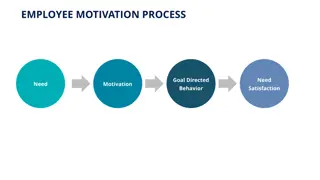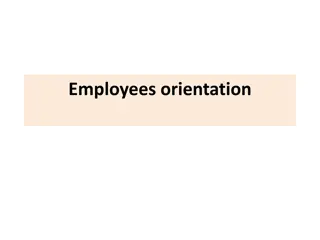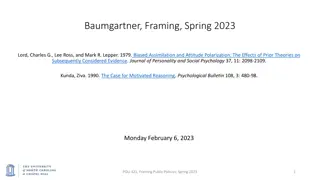Understanding Employee Effort: Evidence from Absenteeism Analysis
This study examines the drivers of employee effort through analyzing patterns of absenteeism across firms. The research explores variations in absenteeism levels, investigates whether incentives or employee characteristics influence effort, and identifies firm characteristics that impact absenteeism. Results indicate significant differences in absenteeism across firms, with organizational structure, family firm status, and competition intensity playing key roles in determining employee effort.
- Employee Effort
- Absenteeism Analysis
- Firm Characteristics
- Organizational Structure
- Competition Intensity
Download Presentation

Please find below an Image/Link to download the presentation.
The content on the website is provided AS IS for your information and personal use only. It may not be sold, licensed, or shared on other websites without obtaining consent from the author. Download presentation by click this link. If you encounter any issues during the download, it is possible that the publisher has removed the file from their server.
E N D
Presentation Transcript
Drivers of Effort : Evidence from Employee Absenteeism Morten Bennedsen, INSEAD & U of Copenhagen Margarita Tsoutsoura, Cornell Daniel Wolfenzon, Columbia & NBER
Introduction Data Results Conclusions Motivation Practices to encourage employee effort are widespread. Examples of policies: Incentive pay Tournaments Profit sharing Other human resource practices TQM, benchmarking, employee participation in decision making These practices are widespread: In the 1990s, 45% of salaried workers in the U.S. had some type of performance pay (Lemieux, McCleod, and Parent, 2009) Black and Lynch (2001) find that other human resource practices are also very common among a representative sample of U.S. firms There is scant evidence comparing employee effort across a representative sample of firms The future of the field may be to move away from purely single firm studies to consider a larger number of firms (Bloom and Van Reenen, 2011) 2
Introduction Data Results Conclusions This paper 1. Is there variation across firms in the average level of employee effort ? 2. Is this variation driven by the type of employees who choose to work in each firm or by the incentives provided by the firm? 3. What firm characteristics gives rise to these incentives? 4. Do policies have heterogeneous effect effects on different group of employees? (senior managers vs workers) 3
Introduction Data Results Conclusions This paper Measure of individual performance: Absenteeism Pros: Can be consistently computed for all employees in all occupations for a large number of firms in a developed economy Because it is measured at the individual (and not firm) level, can identify firm effect by following movers Cons: It is only one dimension of effort (e.g. does not capture intensity of work when in the office) Can be driven by factors not related to effort (e.g health) Not productivity 4
Introduction Data Results Conclusions Overview of Results Show large differences in average absenteeism across firms The difference between firms in the top and bottom decile is 15 days. This variation persists even within industry. Using movers we analyze the role played by two broad set of explanations for this difference: Incentives vs Selection 53% of the difference in average days absent is driven by incentives . Results are robust using only absences around national holidays and weekends What firm characteristics matter Organizational structure (hierarchy) and family firm status matter for workers effort More intense competition discourages managers effort 5
Introduction Data Results Conclusions Literature Two types of studies: 1. Single policy, single firm studies with individual level productivity Example: fixed wages to piece rates Lazear (2000): Windshield installers in Safelite Glass Company Bandiera et al. (2007): Managers in a U.K. fruit farm Freeman and Kleiner (2005): Workers in a U.S. shoe manufacturer Shearer (2004): Tree planters in British Columbia 2. Multiple firms and firm level productivity Some studies on the associations of policies and firm level productivity (endogeneity issues) RCT in developing countries Karlan and Valdivia (2009), Bruhn et. al. (2010), Bloom et al. (2010) 6
Introduction Data Results Conclusions Contribution to Literature Know little about the effectiveness of these tools in a representative firm in a developed economy Ichino & Maggi (2000): shirking differentials in a large Italian bank. Since it is one firm they do not have variation in firm characteristics. Selection vs incentives Use of movers for identification Movers affected by a different set of firm policies (origin vs destination) As opposed to previous literature, does not require to find changes in firm policies Easier to detect movers than firm policy changes Sidesteps the issue of endogenous policy change although now need to think about endogeneity of moves Of course, the empirical methodology is not new Neither are the checks for endogenous mobility 7
Data 8
Introduction Data Results Conclusions Data Sources Days Absent Survey on Employee Absence by Statistics Denmark Individual data on employee absences: (a) own sickness, (b) child sickness, (c) accident at the workplace. For the private sector absence data are gathered by Statistics Denmark for a sample of 4,140 companies and approximately 665,000 unique employees 60% of employment in the private sector It includes: all firms with more than 250 employees and a sample of firms with 10-250 employees Includes every spell of absence for each employee We focus on full-time employees Years: 2007-2013 9
Introduction Data Results Conclusions Days Absent: Description and Institutional Details Employers have a strong incentive to report Firm is required to pay sickness benefits for the first 30 days of sickness Danish Government pays after this initial period Easy to report Statistics Denmark developed software that links to firm s payroll system Measure of sick days not vacation time All employees have the right to 5 weeks (25 days) of holidays every year Any adjustments are negotiated with the unions of specific industries and not at the firm level 10
Introduction Data Results Conclusions Sickness Absence Average Across Countries Denmark is similar to US Just below the 2.8% average 11
Introduction Data Results Conclusions Other Data Sources Matched employee-employer data (IDA) Employer ID, employee s position in firm and wage Employee Demographics: Age, gender, education Hospitalization data from National Patient Registry Number of days every person spends at the hospital Financial and management data are from Experian Audited financial statements Name of all managers and CEOs SumStat SumStat 12
Introduction Data Results Conclusions Absent days: does it matter for firm/employees? It might: Reduces labor supply which is an input of production But it might not: Employee might work from home instead Employee might compensate by working more other days Direct evidence: Promotions & separations are affected by absences Preliminary evidence on firm performance There is additional evidence that absences matter in other settings (education) 13
Introduction Data Results Conclusions Does it matter for employees? Promotion Separation (3) (1) (2) (4) Days Absentt-1 -0.0003*** (0.0001) -0.0002*** (0.0001) 0.0005*** (0.0001) 0.0004*** (0.0001) Observations R-squared Industry FE Year FE Employee Characteristics Employee FE Firm Controls 925,894 0.0597 Yes Yes Yes No Yes 925,894 0.3921 Yes Yes Yes Yes Yes 943,210 0.0180 Yes Yes Yes No Yes 943,210 0.6925 Yes Yes Yes Yes Yes One additional absence day decreases prob. of promotion by 0.03% (annual prob. of promotion is 6%). One additional absence day increases prob. of separation by 0.05% (annual prob. of separation is 8%). 14
Introduction Data Results Conclusions Absent days: does it matter for the firm? Dependent Variable: Performance Less than 100 Employees (1) 0.0000 (0.0007) -0.0079*** (0.0030) 0.0004 (0.0029) 0.3120*** (0.0935) More than 100 Employees (2) -0.0008** (0.0004) -0.0079*** (0.0015) -0.0000 (0.0000) 0.3740*** (0.0586) More than 300 Employees (3) -0.0011* (0.0006) -0.0065*** (0.0020) -0.0000 (0.0000) 0.3228*** (0.0815) Days Absentt-1 Firm Age Firm Assets Constant Observations R-squared Year FE Firm Controls Firm FE No.firms 3,499 0.8058 Yes Yes Yes 1,652 4,078 0.7127 Yes Yes Yes 1,236 1,932 0.7035 Yes Yes Yes 550 15
Introduction Data Results Conclusions Variation in firm level absenteeism Our measure at the firm level: 1 ??= ??? ??? ? ?:? ?,? =? There are large differences in days absent across firms Above/below Median (1) Top/bottom 25% (2) Top/bottom 10% (3) Top/bottom 5% (4) Difference in days absent: 6.288 10.353 15.656 20.046 16
Introduction Data Results Conclusions Variation in firm level absenteeism Table Table 17
Results 18
Results Introduction Data Conclusions Decomposition into individual and firm components Model for employee days absent yit= i+ ???+ J(?,?)+ t+ eit i+ ??? is the portable component of employee behavior i captures time-invariant characteristics motivation, discipline, sense of responsibility ??? captures effect of no. children, health status, wage etc J(?,?) captures the effect of the firm on all its employees These firm fixed effect are the main focus of the paper At a later stage we will try to explain these s as a function of firm characteristics movers Need movers to separately identify firm and firm fixed effects Aggregating results at the firm level 19
Results Introduction Data Conclusions Decomposition of Absence Gap Above/below Median (1) Top/bottom 25% (2) Top/bottom 10% (3) Top/bottom 5% (4) Difference in days absent: Overall Due to incentives Due to selection 6.288 3.361 2.926 10.353 5.958 4.395 15.656 9.416 6.240 20.046 12.979 7.067 Share of difference Due to incentives 0.534 (0.058) 0.466 0.575 (0.051) 0.424 0.601 (0.079) 0.398 0.648 (0.097) 0.352 Due to selection Mover SumStat Mover SumStat 21
Results Introduction Data Conclusions Alternative Tests Isolate absences more likely to be discretionary : Obtain similar results when use absence spells that started on Monday, Friday and around a holiday And we were already controlling for health, age, number of kids 22
Results Introduction Data Conclusions Exogenous mobility Unobserved time-varying component of employee behavior that determines move Example: Change in motivation become lazy Concern: People with decrease in motivation move to firms with high absenteeism Estimation overstates firm fixed effects Match-component of employee behavior Example: Specific firm-employee fit Concern: Employees move to firm where fit is best 23
Results Introduction Data Conclusions Event Study of Movers Specification Specification 24
Results Introduction Data Conclusions So far Large variation in days absent Our results show that 53-64% of the variation across firms in can be attributed to workplace environment What firm characteristics correlate (explain) with these firm effects? 25
Results Introduction Data Conclusions Explaining the firm fixed effects We run the following cross-sectional regression ??= ???+ ?? where z are firm characteristics Note results are not driven by employee selection but we do not have exogenous variation in z We standarize the covariates to have mean of zero and sd of 1 26
Results Introduction Data Conclusions Observable correlates of fixed effects 27
Results Introduction Data Conclusions Firm fixed effects for different types of employees We classify employees into 2 groups: managers and workers We estimate the model separately on these two groups 28
Results Introduction Data Conclusions Managers/ Non-Managers 29
Introduction Data Results Conclusions Conclusion We use employee level absenteeism to proxy for employee effort We find large differences across firms in abstenteeism We find that 53-63% of the variation in firm average days absent across firms is due to incentives We find the firm effect to be correlated with Hierarchy non-managers Family firm status/ownership concentration, specially for non- managers Competition, specially for managers 30
Introduction Data Results Conclusions Change in Days Absent by Size of Move 10 slope=0.60 Change of absent days on move 5 0 -5 -10 -10 -5 0 5 10 Destination-origin difference Difference in absence between destination and origin firm 31
Introduction Data Results Conclusions Days absent: does it contain information? 100 90 80 70 Days Absent 60 50 45-65 years old 40 30 20 20-45 years old 10 0 0 1 4 7 10 13 16 19 22 25 28 Hospitalization Days 32
Introduction Data Results Conclusions Absent days: is it discretionary? 100 90 80 70 60 Days Absent 50 High Level 40 30 20 Intermediate and Low Level 10 0 0 1 4 7 10 13 16 19 22 25 28 Hospitalization Days We will also use absent spells that start on Monday or Friday and spells that start around 2 days of a national holiday 33
Introduction Data Results Conclusions Days absent: does it matter for the firm? Dependent Variable: Performance (OROA) Less than 100 Employees (1) 0.0000 (0.0007) -0.0079*** (0.0030) 0.0004 (0.0029) 0.3120*** (0.0935) More than 100 Employees (2) -0.0008** (0.0004) -0.0079*** (0.0015) -0.0000 (0.0000) 0.3740*** (0.0586) More than 300 Employees (3) -0.0011* (0.0006) -0.0065*** (0.0020) -0.0000 (0.0000) 0.3228*** (0.0815) Days Absent Firm Age Firm Assets Constant Observations R-squared Year FE Firm Controls Firm FE No.firms 3,499 0.8058 Yes Yes Yes 1,652 4,078 0.7127 Yes Yes Yes 1,236 1,932 0.7035 Yes Yes Yes 550 34
Introduction Data Results Conclusions Movers Distribution of Destination-Origin Difference in Days Absent Share of Movers Mean=0.06 SD=3.87 Return Return 35
Results Introduction Data Conclusions Event study If we focus only on movers that move only once from origin firm o(i) to destination firm d(i), we can re-write yit= i+ ???+ J(?,?)+ t+ eit as d ? o ? ?? ? ?? ? yit= i+ ???+ o(?)+ ? t > Ti ( ?? ? ?? ?) + t+ eit S incentives We estimate yit= i+ ???+ ? t > Ti ( ?? ? ?? ?) + t+ eit Return Return 36
Introduction Data Results Conclusions Variation in firm level absenteeism The differences are there even if we look within industries Above/below Median (1) Top/bottom 25% (2) Top/bottom 10% (3) Top/bottom 5% (4) Difference in absence: Manufacturing Construction Retail, Hotels & Restaurants Transportation & Telecommunication Finance and Insurance Education and Healthcare 5.453 6.206 6.280 6.473 6.734 10.701 8.894 10.03 10.089 10.749 11.260 18.099 13.455 15.225 14.689 16.751 18.514 29.638 17.729 20.277 18.391 23.007 26.554 41.286 Boxplot Boxplot 37
Introduction Data Results Conclusions Summary Statistics Firms All 0.0757 (0.0007) [257,397] 0.0433 (0.0005) [257,392] 51.8463 (0.8400) [257,432] 2.8465 (0.0082) [257,431] 38.5082 (0.3553) [257,636] 22.9027 (0.1416) [256,356] All -sample firms 0.0599 (0.0025) [7,678] 0.0349 (0.0022) [7,673] 364.1203 (9.7585) [7,713] 4.9601 (0.0340) [7,712] 179.0560 (3.5823) [7,917] 35.0215 (0.5679) [7,867] Diff Sample vs All -0.0267*** (0.0026) [257,397] -0.0087*** (0.0023) [257,392] 321.9191*** (9.7870) [257,432] 2.1789*** (0.0349) [257,431] 145.0036*** (3.5965) [257,636] 12.5025*** (0.5860) [256,356] OROA Net Income/assets Assets Ln(Assets) No. of employees Firm age Sample firms are larger and older than average firm in Denmark 38
Introduction Data Results Conclusions Summary Statistics Employees All All -sample firms Diff Sample vs All 425,184 (8458.332) 41.1428 (.2802) 0.6207 (.0089) Employee wage 306,750 (3143.6150) 38.5200 (.1747) 0.6625 (.0041) 147,087*** (8864.1990) 3.2780*** (.3381) -0.0523*** (.0100) Employee age Male Hospitalization Days 0.2512 (.0017) 0.2095 (.0038) -.0520*** (.0042) Sickness Absence 7.6321 (.3042) 1.2647 (.0170) No. of Children 1.3843 (.0093) -.1488*** (.0200) Return Return 39
Introduction Data Results Conclusions Summary Statistics Movers vs Non Movers Non-Mover Mean 0.4025 0.3209 1.27 Mover Mean 0.3705 0.3647 1.22 Female Bachelor degree No. of Children Age 30 30 - 40 40 - 50 50 - 60 Age 0.1879 0.2682 0.2937 0.203 41.81 0.1954 0.3133 0.2993 0.1669 40.48 Absent Days Hospital Event 7.92 0.0551 7.06 0.0512 Return Return 40























